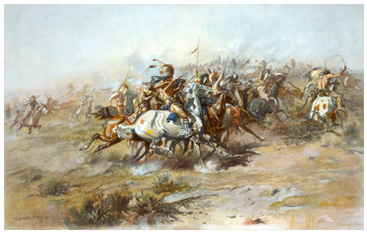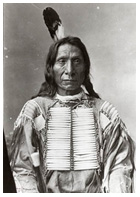

In 1874, Lt. Colonel George Armstrong Custer, commander of the 7th U.S. Cavalry Regiment, led an expedition into the Black Hills of South Dakota. He sent the following dispatch to the New York Times that would spark a national frenzy. Interactive popup. Assistance may be required. Gen. Custer's Report
St. Paul, Minn. Aug. 22 — Gen. Custer, in his report on an expedition to the Black Hills says, "I referred in a former dispatch to the discovery of gold. Subsequent examinations at numerous points confirm and strengthen the fact of the existence of gold in the Black Hills and some of the water-courses. Almost every earth produced gold in small yet paying quantities. . .It has needed no expert to find gold in the Black Hills, as men without former experience in mining have discovered it at an expense of but little time or labor."  to read an excerpt from his report of August 22, 1874 and then answer the questions that follow:
to read an excerpt from his report of August 22, 1874 and then answer the questions that follow:
What is the main point of Custer’s report?
Interactive popup. Assistance may be required. There was a large amount of gold that was easy to mine in the Black Hills.
What do you think many people wanted to do after reading this article in the New York Times?
Interactive popup. Assistance may be required. People would become excited about the chance to strike it rich by finding gold and they would move to South Dakota.
The discovery of gold, like what occurred in California in 1849, will always spark many people to move in the hopes of striking it rich. What was going on in the country in 1874 that might have caused more people than normal to move to the Black Hills?
Interactive popup. Assistance may be required. By 1874, the United States was at the beginning of a depression and had a high unemployment rate. People who were out of work would be extra-tempted to solve their money problems by finding gold, especially because Custer made it sound so easy that men with no experience discovered it.
 As you probably were able to guess in the previous section, reports from the Custer Expedition started a gold rush to South Dakota. Towns were founded almost overnight as thousands of fortune-seekers arrived. They quickly moved about trying to find the gold that was in abundance. The most successful mine, the Homestake Claim, actually produced gold until it was closed in 2001.
As you probably were able to guess in the previous section, reports from the Custer Expedition started a gold rush to South Dakota. Towns were founded almost overnight as thousands of fortune-seekers arrived. They quickly moved about trying to find the gold that was in abundance. The most successful mine, the Homestake Claim, actually produced gold until it was closed in 2001.
There was one small problem—the Black Hills did not belong to the federal government or the miners. The U.S. Army and the Sioux fought repeatedly during the 1860s, culminating in Red Cloud’s War from 1866-1868, named after the great American Indian leader of the Lakota Sioux Nation. The two-year war was won by the Sioux and ended with the Treaty of Fort Laramie, which gave the Sioux the Black Hills forever as part of the Great Sioux Reservation.
 The Black Hills were considered sacred by the Sioux as the center of their culture. The influx of miners violated the Treaty of Ft. Laramie and was considered a deep insult to the American Indians. By this time, they no longer trusted the federal government to live up to its agreements. The two sides resumed fighting, which ultimately led to the massacre of 850 U.S. soldiers under the command of Custer at Little Big Horn in 1876, popularly known as Custer’s Last Stand.
The Black Hills were considered sacred by the Sioux as the center of their culture. The influx of miners violated the Treaty of Ft. Laramie and was considered a deep insult to the American Indians. By this time, they no longer trusted the federal government to live up to its agreements. The two sides resumed fighting, which ultimately led to the massacre of 850 U.S. soldiers under the command of Custer at Little Big Horn in 1876, popularly known as Custer’s Last Stand.
Nevertheless, the U.S. government continued to press, and in 1877 it forced the Sioux to give up their claims to the sacred Black Hills. The two sides would continue to fight for another 14 years until the United States defeated the Sioux once and for all at Wounded Knee in 1890.
Analyze: How did the Black Hills Gold Rush and the Panic of 1873 help speed up the decline and defeat of the Lakota Sioux?
Interactive popup. Assistance may be required. The Black Hills Gold Rush, fueled in part by the Panic of 1873, suddenly made the Sioux’s most sacred lands highly desirable by the United States despite its treaty giving it to the Sioux. This quickened the resumption of fighting between the United States and the Sioux, a fight the American Indians could not win in the long run.

Red Cloud was one of the only American Indian chiefs to decisively defeat the U.S. military, forcing the Treaty of Fort Laramie. He also proved very shrewd when dealing with the U.S. government, winning concessions but never trusting it.
Red Cloud lived until 1909 and in his old age he reflected on the wars in the Great Plains with the following famous quote: "They made many promises, more than I can remember, but they never kept but one. They promised to take our land, and they did."
Reflection: Were the Sioux justified in fighting the federal government to keep control of the Black Hills? Should they have simply negotiated them away for a price?